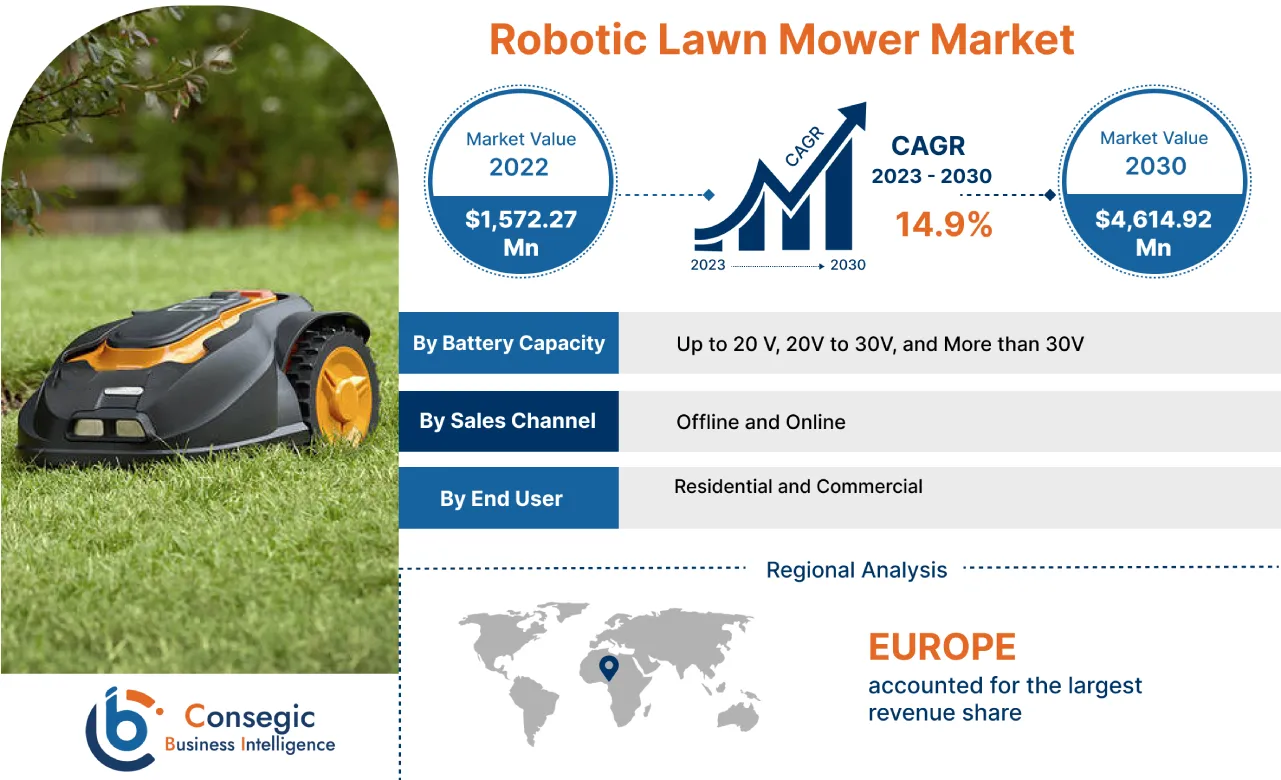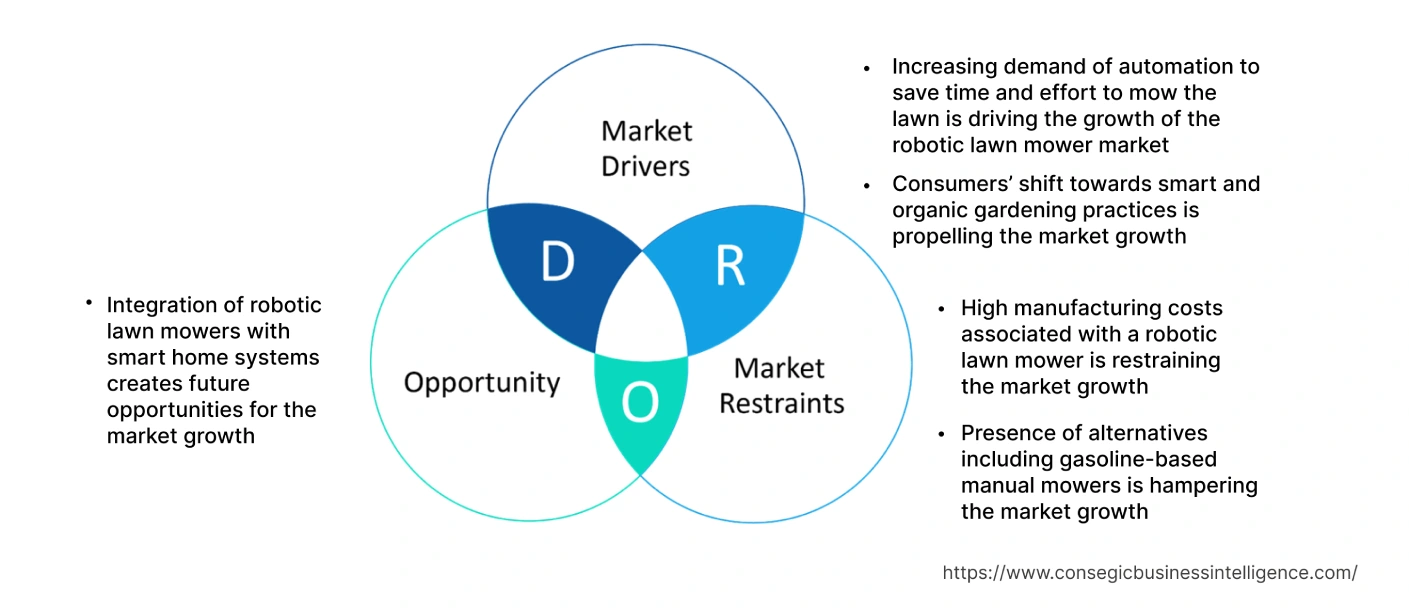Robotic Lawn Mower Market Size :
Robotic Lawn Mower Market size is estimated to reach over USD 4,614.92 Million by 2030 from a value of USD 1,572.27 Million in 2022, growing at a CAGR of 14.9% from 2023 to 2030.
Robotic Lawn Mower Market Scope & Overview:
A robotic lawn mower is a type of autonomous device designed to trim lawns without human intervention. The instrument operates using sensors, programming, and motorized cutting blades. Additionally, robotic mowers are becoming increasingly popular due to the convenience and ability to save time and effort for homeowners. Furthermore, robotic mowers are capable of operating independently, navigating the lawn, and mowing the grass without human control.
Robotic Lawn Mower Market Insights :
Robotic Lawn Mower Market Dynamics - (DRO) :
Key Drivers :
Increasing demand of automation to save time and effort to mow the lawn is driving the robotic lawn mower market growth
Robotic lawn mower provide a convenient solution by automating the task of lawn maintenance and eliminating the need for manual mowing, saving homeowners time and effort. Additionally, the advancements in technology including the emergence of sensors to detect obstacles, boundary wires to restrict the mowing area, and tilt sensors to stop the blades are further accelerating the market trends. The advanced safety features reduce the risk of injuries associated with traditional lawn mowing including slips, falls, and contact with sharp blades, thus contributing significantly in propelling the market trends. Moreover, the emergence of smart features that allow lawn mowers to automatically schedule the mowing task based on weather conditions is further driving the market trends. For instance, in January 2023, Heisenberg Robotics introduced LawnMeister H1 modular autonomous lawnmower with leaf-blowing and watering modules. As per the analysis, the advanced autonomous lawn mower operates seamlessly in different terrains and automatically schedules the lawnmowing task based on weather conditions, thus contributing remarkably in accelerating the market development.
Consumers' shift towards smart and organic gardening practices is propelling the market expansion
Smart gardening involves the application of technology to optimize and automate various aspects of gardening. They fit seamlessly into smart gardening systems by providing automated lawn care. Additionally, organic gardening emphasizes the utilization of natural and sustainable practices, reducing the reliance on chemicals and minimizing environmental impact. They align with such ethos by offering eco-friendly alternatives to traditional gas-powered mowers. Robotic mowers are typically electric-powered, producing zero emissions and reducing carbon footprints.
Furthermore, the mowers also feature mulching capabilities, recycling grass clippings as natural fertilizer, eliminating the need for additional chemicals. Consequently, the incorporation of robotic mowers into smart gardening creates a large customer base for efficient and intelligent gardening, thus contributing remarkably in driving the market expansion. For instance, in May 2022, Toro launched a battery-powered robotic mower with cutting-edge technology to offer sustainable gardening practices. Based on the analysis, product is designed to provide wire-free navigation with zero emissions to minimize the environmental impact, hence contributing considerably in boosting the market development.
Key Restraints :
High manufacturing costs is restraining the market
The cost of production of robotic mower is expensive and limits the adoption of robotic mowers by small enterprises. Additionally, these mower have a higher upfront cost as compared to traditional lawn mowers which compels the user to opt for traditional lawn mowers. Moreover, based on the analysis, the advanced technology, sensors, and autonomous capabilities incorporated into such machines contribute to the higher price, thus restraining the global robotic lawn mower market trends.
Presence of alternatives including gasoline-based manual mowers is hampering the market
Gasoline-based manual mowers have a lower upfront cost compared to these lawn mower, restraining the expansion of the market. Additionally, gas-powered manuals offer better maneuverability and control with complex terrains, steep slopes, or uneven surfaces. Manual lawn mowers handle rough or hilly terrains more effectively, allowing users to navigate challenging areas with greater precision. Furthermore, these lawn mowers require electricity to operate and need to be charged regularly. Gasoline-based manual mowers, on the other hand, do not rely on electricity and are operated easily without the need to monitor battery levels, thus impeding the robotic lawn mower market demand.
Future Opportunities :
Integration of robotic lawn mower with smart home systems creates future opportunities for the market
Smart home integration allows users to control and monitor the robotic mower remotely through smartphone apps or voice assistants, which are creating lucrative robotic lawn mower market opportunities and trends are propelling the market in the coming years. The integration allows users to schedule mowing sessions, adjust settings, and receive notifications about the mower's status. Additionally, as per the analysis, smart home integration enables the collection and analysis of data from robotic mowers. The data collected provide valuable insights into lawn health, mowing patterns, and performance metrics. Users access analytics and recommendations to improve lawn care practices including adjusting watering schedules or identifying areas that require extra attention. In conclusion, data-driven insights empower homeowners to make smart decisions to achieve better lawn maintenance results, thus projected to create potential opportunities and robotic lawn mower market trends in the forecast years.
Robotic Lawn Mower Market Report Insights :
| Report Attributes | Report Details |
| Study Timeline | 2017-2030 |
| Market Size in 2030 | USD 4,614.92 Million |
| CAGR (2023-2030) | 14.9% |
| By Battery Capacity | Up to 20 V, 20V to 30V, and More than 30V |
| By Sales Channel | Offline and Online |
| By End-User | Residential and Commercial |
| By Region | North America, Europe, Asia-Pacific, Latin America, and Middle East & Africa |
| Key Players | ANDREAS STIHL AG & Co. KG, Robert Bosch GmBH, Husqvarna Group, Globgro AB, Hitachi, Ltd., HONDA MOTOR CO., LTD., Positec Germany GmbH, Robomow Friendly House, STIGA S.p.A., The Toro Co., WIPER S.R.L., WOLF-Garten company |
| Geographies Covered | |
| North America | U.S. Canada Mexico |
| Europe | U.K. Germany France Spain Italy Russia Benelux Rest of Europe |
| APAC | China South Korea Japan India Australia ASEAN Rest of Asia-Pacific |
| Middle East and Africa | GCC Turkey South Africa Rest of MEA |
| LATAM | Brazil Argentina Chile Rest of LATAM |
| Report Coverage | Revenue Forecast, Competitive Landscape, Growth Factors, Restraint or Challenges, Opportunities, Environment & Regulatory Landscape, PESTLE Analysis, PORTER Analysis, Key Technology Landscape, Value Chain Analysis, Cost Analysis, and Regional Trends & Forecast |
Robotic Lawn Mower Market Segmental Analysis :
By Battery Capacity :
The battery capacity segment is trifurcated into up to 20 V, 20V to 30V, and more than 30V. The 20-30V capacity robotic mower accounted for the largest global robotic lawn mower market share of 41.35% in 2022 as robotic mower with a capacity of 20-30V maintain a balance between power and size. The voltage range provides sufficient power to efficiently mow the lawns, thus contributing considerably in accelerating the market expansion. Additionally, robotic mowers with a 20-30V capacity maintain a balance between performance and battery life. Based on the analysis, the mowers offer adequate power for efficient cutting and navigation and also ensure a sufficient runtime to cover the target area before requiring a recharge. The balance allows homeowners to complete the lawn maintenance tasks without interruptions and with reasonable energy efficiency, thus contributing significantly in driving the trends of the market.
More than 30V battery capacity segment is projected to witness the fastest CAGR in the robotic lawn mower market during the forecast period. Robotic mowers with higher voltage capacities offer more power and performance capabilities to handle larger lawns more efficiently and effectively. The mowers feature stronger motors, improved cutting systems, and enhanced navigation technologies to tackle rough terrain, thicker grass, and complex yard layouts. For instance, in October 2020, Toro launched a battery-powered 60V heavy-duty mower for commercial applications. The emission-free lawn care fleet of mowers is designed to provide faster mowing speeds, longer battery life, improved obstacle detection, and precision cutting, hence contributing remarkably in driving the development of the above 60V battery capacity segment.
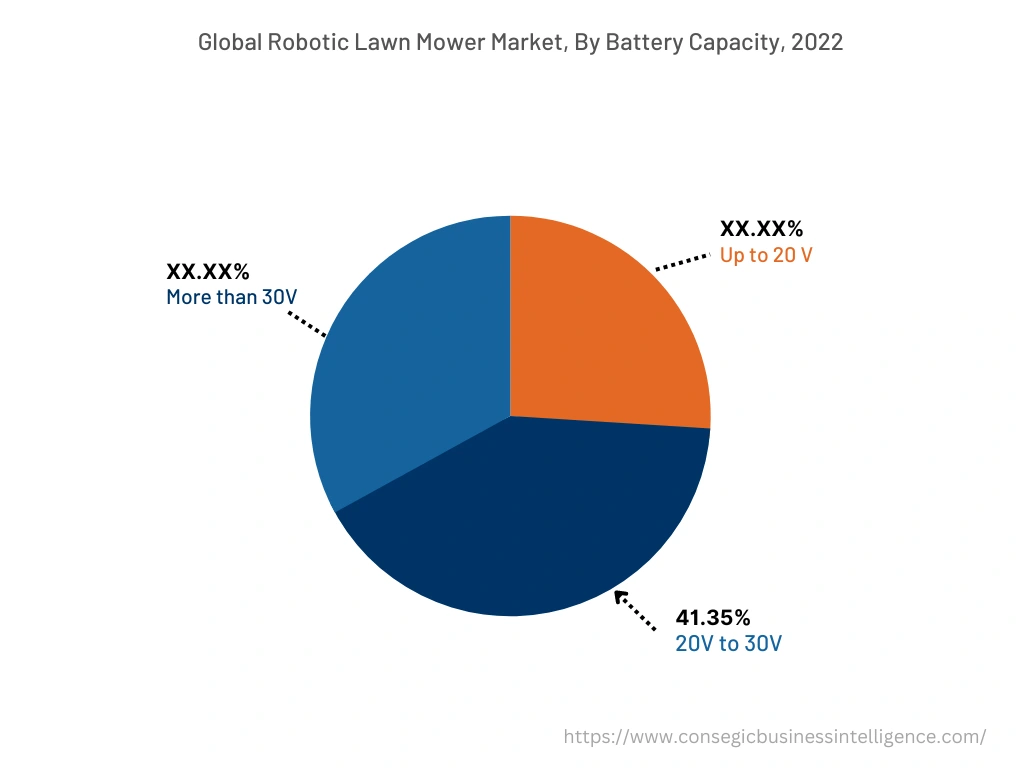
By Sales Channel :
The sales channel segment is bifurcated into offline and online. Offline channel accounted for the largest market share in 2022 as customers prefer direct experience with the product before making a purchase. Additionally, offline sales channels enable customers to physically examine robotic mowers, ask questions to sales representatives, and assess the quality and features of the product. Moreover, offline sales channels offer personalized assistance and guidance throughout the purchase process. Sales representatives provide expert advice and assists customers to choose the right model based on the specific needs and lawn requirements, further driving the trends of the offline sales channel. Furthermore, offline sales channels provide post-purchase services including product setup, installation, and maintenance guidance, and also offer additional services including warranty support, repair services, and spare parts availability. Consequently, the aforementioned factors are collectively responsible in accelerating the expansion of the offline sales channel of the robotic lawn mower market.
The online segment is projected to witness the fastest CAGR in the robotic lawn mower market during the forecast period. The trends is attributed to the rise in the global e-commerce industry with more consumers opting to shop online for convenience, a wide product selection, and competitive pricing. In addition, the online segment allows customers to browse and compare different models, read product reviews, and make purchases from the comfort of the homes. Furthermore, online sales channels offer customers the flexibility to compare different options and make purchases based on the budget. In conclusion, the ability of the online marketplace to provide a wide product range and availability act as a compelling reason for customers to choose online channels for purchasing robotic mowers.
By End-User :
The end-user segment is bifurcated into residential and commercial. The residential segment accounted for the largest market share in 2022 as robotic mower offer homeowners the convenience of independently navigating the garden and cutting the grass to a predetermined height and pattern. Additionally, the advancements in technology including satellite navigation technology enable improved obstacle detection and faster mowing speeds in residential gardens. Furthermore, robotic mower save homeowners time and effort and promote healthier grass growth by reducing stress on the lawn, thus contributing notably in driving the trends of the market. For instance, in October 2022, Husqvarna launched a virtual boundary robotic mower for private gardens. The product is equipped with an advanced satellite navigation system that allows an improved obstacle detection process by effectively operating on rough terrain and slopes, thus contributing remarkably in driving the market growth.
The commercial segment is anticipated to witness the fastest CAGR in the robotic mower during the forecast period. Robotic mowers are ideal for maintaining sports fields including football fields, golf courses, and cricket pitches. The ability of robotic mower to allow precise cutting patterns and adjust mowing heights contributes in enhancing the aesthetics and playability of the fields. Additionally, various commercial complexes, business parks, and office campuses have extensive lawns and green spaces that require regular maintenance. Robotic mowers offer an efficient solution for keeping such areas well-manicured by autonomously navigating around obstacles, reducing the need for manual labor, and minimizing disruptions to daily operations. In conclusion, the increasing adoption of robotic mower in the commercial industry offering precise cutting patterns is contributing significantly in driving the market growth in the upcoming years.
By Region :
The regional segment includes North America, Europe, Asia Pacific, Middle East and Africa, and Latin America.
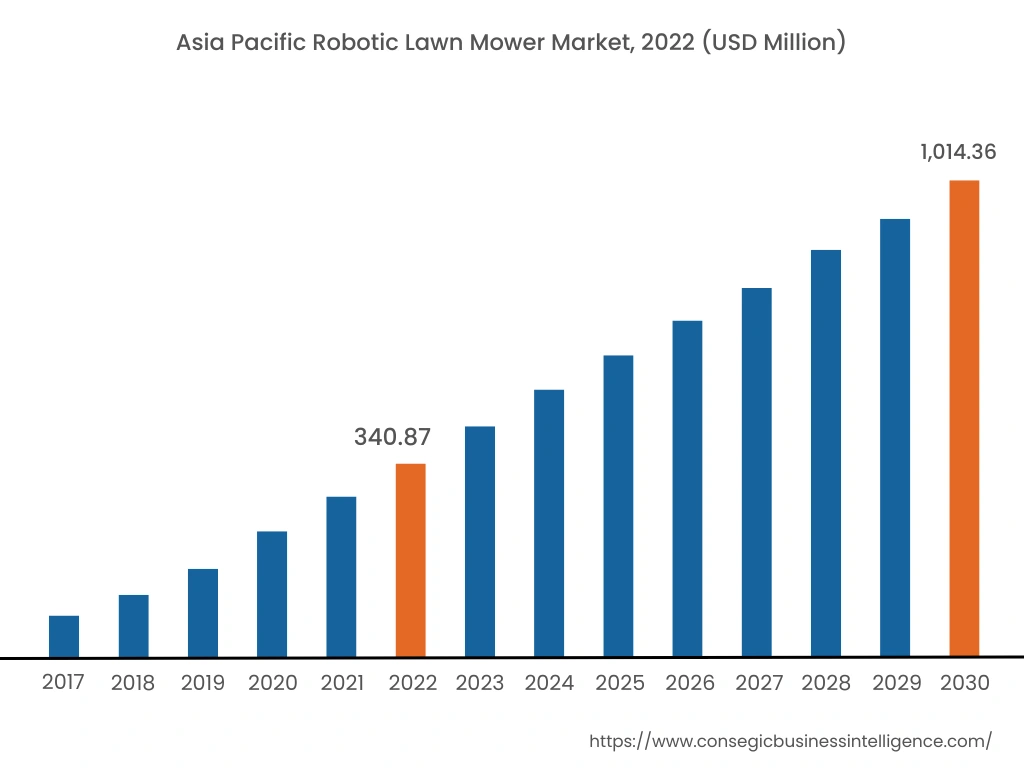
Europe accounted for the largest revenue share in the year 2022 as the region is witnessing early adoption of robotic technology in various industry, including lawn care. Additionally, Europe has been at the forefront of environmental consciousness and sustainability that increases the demand for robotic mower in meticulous lawn maintenance. Based on the robotic lawn mower market analysis, these mowers being electric-powered and emission-free, align well with Europe's focus on reducing carbon footprints and promoting eco-friendly practices. The environmental benefits offered by robotic mowers have resonated with European consumers, driving the demand for such products in the region. Additionally, the presence of key players in the region, including Husqvarna Group, Robert Bosch GmBH, and STIGA S.p.A invests heavily in R&D to develop cutting-edge technology, advanced navigation systems, and efficient cutting mechanisms. For instance, in October 2022, Husqvarna launched CEORA with systematic mowing technology and a satellite navigation system to offer cost-effective and sustainable landscape maintenance operations. The high-performing, zero-emission, and low-noise CEORA mows independently and analytically within virtual boundaries, thus contributing significantly in driving the market growth in European countries.
Asia Pacific accounted to USD 340.87 million in 2022 and is expected to register the fastest CAGR of 15.1% accounting to USD 1,014.36 million in 2030. In addition, in the region, China accounted for the maximum revenue share of 27.45% in the year 2022. The growth is attributed to the increasing demand of automation resulting in time-saving for household chores, including lawn maintenance. They offer convenience and align with the growing preference for automated solutions in residential settings in Asia-Pacific countries. Additionally, the growing emphasis on sustainable practices in the Asia-Pacific region further raises the demand for advanced robotic mower as the robotic mowers are electric-powered and emission-free, thus contributing significantly in meeting the sustainability goals. Consequently, the aforementioned factors are collectively responsible in driving the growth of the robotic lawn mower market.
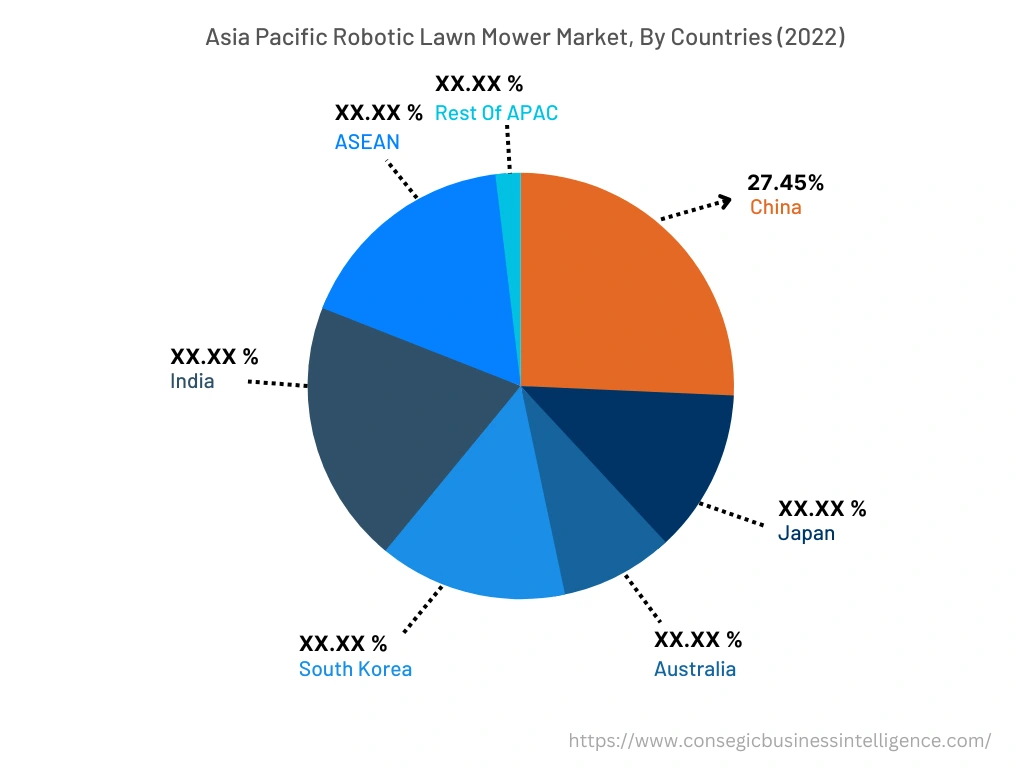
Top Key Players & Market Share Insights:
The landscape of the robotic lawn mower market is highly competitive and has been examined in the report, along with complete profiles of the key players operating in the industry. In addition, the surge in innovations, acquisitions, mergers, and partnerships has further accelerated the growth of the robotic lawn mower market. Major players in the global robotic lawn mower industry include-
- ANDREAS STIHL AG & Co. KG
- Robert Bosch GmBH
- The Toro Co.
- WIPER S.R.L.
- WOLF-Garten company
- Weston Robot Pte Ltd
- Husqvarna Group
- Globgro AB
- Hitachi, Ltd.
- HONDA MOTOR CO., LTD.
- Positec Germany GmbH
- Robomow Friendly House
- STIGA S.p.A.
Recent Industry Developments :
- In September 2022, Greenwich introduced an advanced robotic lawn mower with no direct emissions. The new battery-powered robotic lawn mower uses greener technology and produces no noise as compared to the traditional gas-powered mower.
- In March 2021, The Toro Company acquired Left Hand Robotics, Inc. to improve the market portfolio in advanced technologies for autonomous navigation. The acquisition is considered a strategic decision by Toro to strengthen its expertise in next-generation technologies for manufacturing connected and autonomous equipment including robotic lawn mower.
Key Questions Answered in the Report
What is a robotic lawn mower? +
A robotic lawn mower is a type of autonomous device designed to trim lawns without human intervention.
What specific segmentation details are covered in the robotic lawn mower market report, and how is the dominating segment impacting the market growth? +
The 20-30V capacity robotic lawn mowers dominate the market as robotic lawn mowers with a capacity of 20-30V strike a balance between power and size. The voltage range provides sufficient power to tackle several residential lawn sizes, ensuring efficient cutting performance while maintaining a compact and maneuverable form factor.
What specific segmentation details are covered in the robotic lawn mower market report, and how is the fastest segment anticipated to impact the market growth? +
The commercial segment is predicted to register the fastest CAGR owing to the ability of robotic lawn mowers to allow precise cutting patterns and adjust mowing heights, thus contributing in enhancing the aesthetics and playability of the fields.
Which region is anticipated to witness the highest CAGR during the forecast period, 2023-2030? +
Asia Pacific is anticipated to witness the fastest CAGR during the forecast period owing to the ability of robotic lawn mowers to offer convenience and align with the growing preference for automated solutions in residential settings in Asia-Pacific countries.
